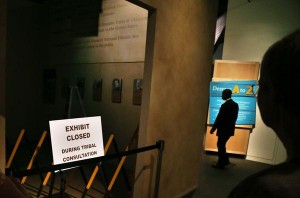History Colorado has made the right decision by closing, temporarily at least, its exhibit on the Sand Creek Massacre while officials consult with the Cheyenne and Arapaho tribes. We’re just sorry it had to come to this.
By The Denver Post Editorial Board August 30, 2013
The clear lesson from this episode is that museum officials should have reached out earlier to the tribes and given them fuller opportunities to voice their concerns.
And their concerns, outlined in reporting by Westword’s Patricia Calhoun over the last several months, were many.

First, the very name of the exhibit, “Collision: The Sand Creek Massacre,” was offensive to many tribal members, who believed the event was being portrayed as an inevitable clash of cultures rather than an indefensible massacre.
On Nov. 29, 1864, U.S. Army soldiers led by Col. John M. Chivington attacked a village along Sand Creek in southeastern Colorado. Soldiers savagely butchered more than 160 Cheyenne and Arapaho, the bulk of them women, children and the elderly.
The massacre was defended at the time as revenge for Indian attacks on white settlers, including the bloody murders and mutilations of a family near present-day Elizabeth.
Nevertheless, a congressional commission later labeled the Sand Creek attack as “foul, dastardly and cruel.”
One of the most damning eyewitness accounts of the massacre came not from the survivors, but from Capt. Silas Soule, who wrote to Gen. Edward Wynkoop afterward.
“I tell you Ned it was hard to see little children on their knees have their brains beat out by men professing to be civilized,” Soule wrote. “One squaw was wounded and a fellow took a hatchet to finish her, and he cut one arm off, and held the other with one hand and dashed the hatchet through her brain.”
Soule, who refused to participate in the massacre, was branded a coward and murdered the following year.
Originally, only an excerpt of his letter was included in the exhibit. The full letter was added after complaints from tribal representatives.
But tribal members still say they wanted more time to discuss the exhibit, which was opened over their objections.
The museum now says it is committed to working with the tribes on how to appropriately depict one of the most tragic events in American history.
That’s a good idea. However, the end product must reflect the best historical consensus of experts.
For the sake of history, and to respect those murdered and their descendants, we hope the museum gets it right this time.
The History Colorado Center closed its Sand Creek Massacre exhibit earlier this year while it consults with tribal families. (Brennan Linsley, The Associated Press)


